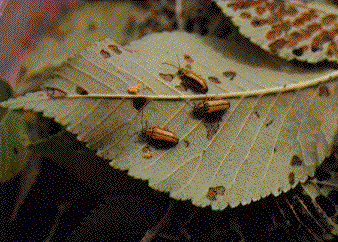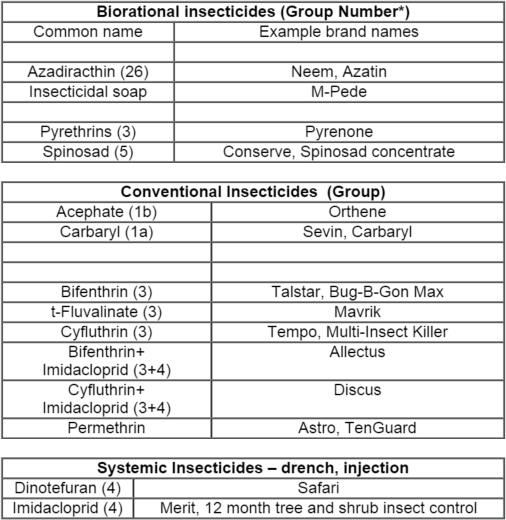Elm Leaf Beetles
ENTFACT-400: Elm Leaf Beetles | Download PDF
by Lee Townsend, Extension Entomologist
University of Kentucky College of Agriculture
 Adult Elm Leaf Beetles
Adult Elm Leaf Beetles
Adult elm beetles are about 1/4 inch long and yellow to olive green with a dark stripe down each side of their wing covers. There are usually four dark spots on the body segment right behind the head.
The orange eggs are spindle‑shaped and the larvae are wormlike, black or black and yellow and up to 1/2 inch long. The pupae are orange‑yellow with black bristles.
Adult elm leaf beetles overwinter in protected locations, often in houses or other structures. They emerge in the spring and move to elm trees where they lay their eggs in groups of 5 to 25 on the underside of leaves. The larvae skeletonize the leaves making them appear netlike. Elm leaf beetle larvae often move to the base of the tree in large numbers to pupate. There are two complete generations per year.
Elm leaf beetle adults move into buildings in the fall to seek hibernation sites. They cause no damage but large numbers of them can be a nuisance.
The most effective control of elm leaf beetles is accomplished by controlling the larvae or adults while they are still on the tree. Treat when leaves are first fully expanded in the spring and again in July.
Pest Proofing
Elm leaf beetles may enter homes and buildings in the fall while searching for protected overwintering sites. See Entfact 641: How to pest-proof your home for tips on keeping them out.

* Insecticides with the same Group Number have the same mode of action against the target pest.
Revised: 7/19
CAUTION! Pesticide recommendations in this publication are registered for use in Kentucky, USA ONLY! The use of some products may not be legal in your state or country. Please check with your local county agent or regulatory official before using any pesticide mentioned in this publication.
Of course, ALWAYS READ AND FOLLOW LABEL DIRECTIONS FOR SAFE USE OF ANY PESTICIDE!
Images: University of Kentucky Entomology.
